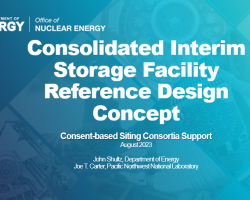Category of Content
Siting Experience Documents Only
Publication Date
Subject Matter
Keywords
Next-Generation Waste Management System Analysis Model (NGSAM) Training Manual
Next-Generation Waste Management System Analysis Model (NGSAM) Training Manual
Generic Design Alternatives for Dry Storage of Spent Nuclear Fuel
Generic Design Alternatives for Dry Storage of Spent Nuclear Fuel
Preliminary Evaluation of Loading DOE Standardized Canisters in the CPP-603 Irradiated Fuel Storage Facility
Preliminary Evaluation of Loading DOE Standardized Canisters in the CPP-603 Irradiated Fuel Storage Facility
Development of Consolidated Fuel Storage Facility Concepts
Development of Consolidated Fuel Storage Facility Concepts
Insight from Public Surveys Related to Siting of Nuclear Waste Facilities: An Overview of Findings from a 2015 Nationwide Survey of US Residents
Insight from Public Surveys Related to Siting of Nuclear Waste Facilities: An Overview of Findings from a 2015 Nationwide Survey of US Residents
M3SF-21SR020401062- Spent Nuclear Fuel and Reprocessing Waste Inventory
M3SF-21SR020401062- Spent Nuclear Fuel and Reprocessing Waste Inventory
Preliminary Evaluation of Removing Used Nuclear Fuel from Shutdown Sites
Preliminary Evaluation of Removing Used Nuclear Fuel from Shutdown Sites
M3SF-21PN020401053- COBRA-SFS Version 6.1 User Guide- A Thermal Hydraulic Analysis Code for Spent Fuel Storage and Transpor
M3SF-21PN020401053- COBRA-SFS Version 6.1 User Guide- A Thermal Hydraulic Analysis Code for Spent Fuel Storage and Transpor
Performance Specification for Standardized Transportation, Aging, and Disposal Canister Systems
Performance Specification for Standardized Transportation, Aging, and Disposal Canister Systems
Development of Consolidated Storage Facility Design Concepts
Development of Consolidated Storage Facility Design Concepts
Standardized Transportation, Aging, and Disposal Canister Feasibility Study
Standardized Transportation, Aging, and Disposal Canister Feasibility Study
Nuclear Fuels Storage and Transportation Requirements Document
Nuclear Fuels Storage and Transportation Requirements Document
Task Order 18 Updated Final Report: Generic Design for Small Standardized Transportation, Aging and Disposal Canister Systems UPDATED FINAL REPORT
Task Order 18 Updated Final Report: Generic Design for Small Standardized Transportation, Aging and Disposal Canister Systems UPDATED FINAL REPORT
Dry Storage Cask Inventory Assessment
Dry Storage Cask Inventory Assessment
Preliminary Used Nuclear Fuel Storage Design Concept
Preliminary Used Nuclear Fuel Storage Design Concept
Summary of Design Criteria for Dry Cask Storage Systems for ISFSI Storage of Shutdown Reactor Spent Nuclear Fuel?
Summary of Design Criteria for Dry Cask Storage Systems for ISFSI Storage of Shutdown Reactor Spent Nuclear Fuel?
Generic Design Alternatives for Dry Storage of Spent Nuclear Fuel
Generic Design Alternatives for Dry Storage of Spent Nuclear Fuel
Generic Design Alternatives for Dry Storage of Spent Nuclear Fuel
Generic Design Alternatives for Dry Storage of Spent Nuclear Fuel
Public Preferences Related to Consent-Based Siting of Radioactive Waste Management Facilities for Storage and Disposal: Analyzing Variations over Time, Events, and Program Designs
Public Preferences Related to Consent-Based Siting of Radioactive Waste Management Facilities for Storage and Disposal: Analyzing Variations over Time, Events, and Program Designs
Guidance for Creating a Community Benefits Plan for Regional Direct Air Capture Hubs
Guidance for Creating a Community Benefits Plan for Regional Direct Air Capture Hubs
This document is intended to provide supplemental information to assist applicants developing a Community Benefits Plan (CBP) for the Regional Direct Air Capture Hubs. As shown in the graphic to the right, Community Benefits Plans are based on a set of four core interdependent policy priorities: engaging communities and labor; investing in America's workforce; advancing diversity, equity, inclusion, and accessibility; and implementing Justice40.
Policies for Achieving Energy Justice in Society: Best Practices for Applying Solar Energy Technologies to Low-Income Housing
Policies for Achieving Energy Justice in Society: Best Practices for Applying Solar Energy Technologies to Low-Income Housing
Studies indicate that the energy burden — energy costs as a percentage of annual family income — on low-income families is inordinately high, compared to that of the rest of the population. Rising fuel costs exacerbate this problem. Residential solar energy systems can help address this situation by furnishing a price-stable energy source with the added benefit of reduced greenhouse gas emissions. However, without appropriate incentives, these systems are prohibitively expensive for low-income families.
Monitored Retrievable Storage Facility Design Criteria Policy Document - 2nd Draft
Monitored Retrievable Storage Facility Design Criteria Policy Document - 2nd Draft
Survey of National Programs for Managing High-Level Radioactive Waste and Spent Nuclear Fuel: 2022 Update
Survey of National Programs for Managing High-Level Radioactive Waste and Spent Nuclear Fuel: 2022 Update
In October 2009, the U.S. Nuclear Waste Technical Review Board (Board or NWTRB) published Survey of National Programs for Managing High-Level Radioactive Waste and Spent Nuclear Fuel. For each of the 13 national programs studied, the report catalogued 15 institutional arrangements that had been set in place and 15 technical approaches that had been taken to design repository systems for the long-term management of high-activity radioactive waste.
Consolidated Interim Storage Facility Reference Design Concept
Consolidated Interim Storage Facility Reference Design Concept
Presentation slides on the Consolidated Interim Storage Facility Reference Design Concept, including site plans; handling, inspection and repackaging concepts and facilities; and cost and staffing estimates.


